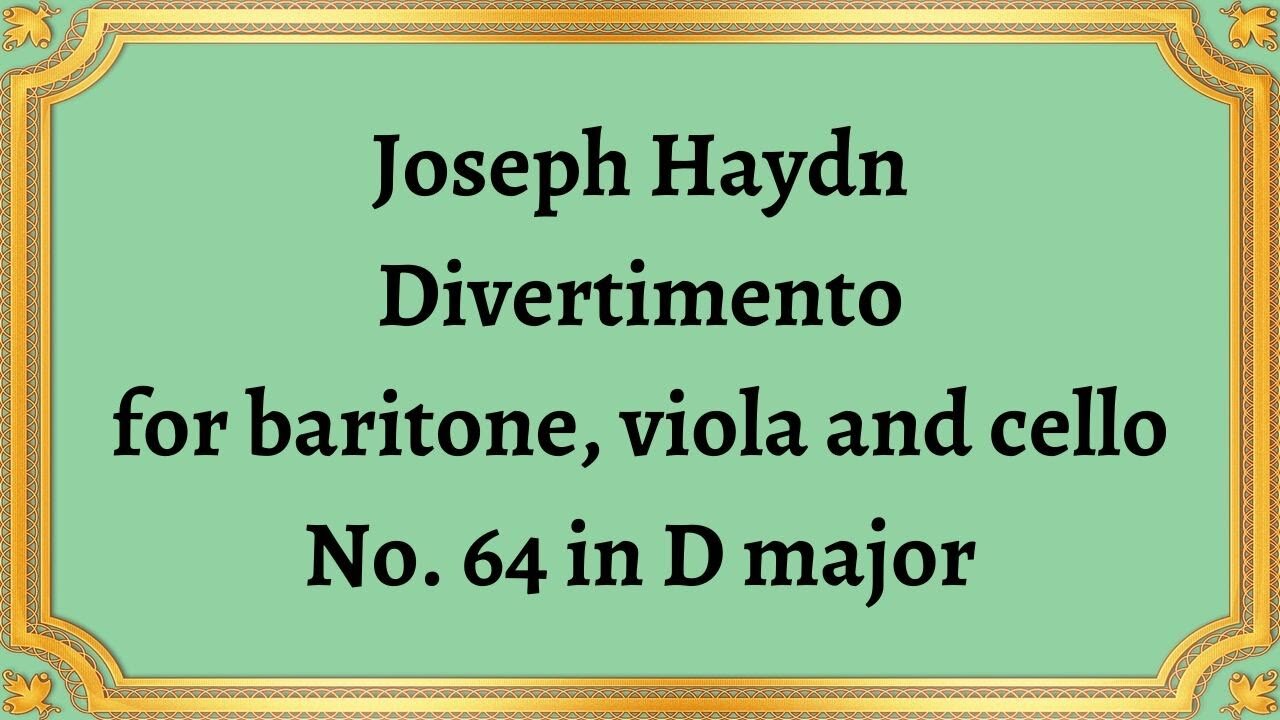Premium Only Content

Joseph Haydn Divertimento for baritone, viola and cello No. 64 in D major
#JosephHaydn #Divertimento #Baritone #Viola #Cello #Dmajor #chambermusic #Adagio #Menuetto #Allegro #classicalmusic #baryton #instrumentation #musiccomposition #ChamberMusicRepertoire
Joseph Haydn, one of the most renowned classical composers, wrote more than 100 divertimentos. The Divertimento for Baritone, Viola, and Cello No. 64 in D major stands out as a unique composition in the chamber music repertoire. It features a rare instrument, the baryton, which Haydn often used to create unique and complex melodies.
The Divertimento for Baritone, Viola, and Cello No. 64 in D major was composed in 1773 upon the request of Prince Nikolaus Esterhazy for his baryton-playing ensemble. The work's instrumentation includes baritone, viola, and cello. Unlike most of his compositions, Haydn used the unusual tuning of the baryton to create a rich tonal palette. The baryton has a set of wire strings on the back of the fingerboard, which when plucked by the left hand produce a unique sound that adds to the piece's texture.
The first movement of the Divertimento is marked as Adagio, which means slowly. The opening melody is played by the viola, interweaving with the cello and baritone in the background. The soaring, and at times, melancholic melody, creates an appreciable ambience. The second movement, marked as Menuetto, is in a 3/4 meter, with a more rhythmic and upbeat feel. As the name suggests, this movement presents a pleasant dance-like style. The trio section of the Menuetto is scored for the baritone and viola in a duet with the cello providing an accompaniment. The final movement, marked as Allegro, is the most technically demanding section of the Divertimento, with the baryton and viola carrying the melody, and the cello providing a rich harmonic foundation. Haydn's use of the baryton in this work is exceptional, as it produces a sound that is not found in any other chamber music composition.
Joseph Haydn's Divertimento for Baritone, Viola, and Cello No. 64 in D major is a significant contribution to the chamber music literature. The composer's ability to create a rich texture using a rarely heard instrument such as the baryton is evident in this composition. Haydn's music has endured centuries, and it's exciting to listen to how he blends the tones from different instruments, creating works that continue to enthrall audiences today.
You have the opportunity to support the channel https://destream.net/live/RadSiarAl/donate
-
 52:11
52:11
Classical music_Music Inspiration
29 days agoAlexandra Glazunov Excerpts from the ballet "Raymonda"
961 -
 LIVE
LIVE
GloryJean
2 hours agoWINNING All Day Long Baby 😎
54 watching -
 LIVE
LIVE
SOLTEKGG
2 hours agoGOING FOR THE WIN WORLD RECORD - BF6 Giveaway
39 watching -
 1:06:37
1:06:37
Chad Prather
15 hours agoApplying The POWER Of Christ To Your Life!
83.2K32 -
 LIVE
LIVE
LFA TV
15 hours agoLIVE & BREAKING NEWS! | FRIDAY 11/7/25
3,699 watching -
 1:05:59
1:05:59
Crypto Power Hour
16 hours ago $0.21 earnedTop 10 Cryptocurrency Staking Platforms
76.6K10 -
 35:53
35:53
Mike Rowe
1 day agoBreaking Down Bill Gates' 3 Tough Truths About Climate | Alex Epstein #457 | The Way I Heard It
90.2K53 -
 23:22
23:22
Stephen Gardner
1 day ago🚨BREAKING: Mamdani Won and What Trump EXPOSES About It is SHOCKING!!
65.1K147 -
 1:16:41
1:16:41
Steve-O's Wild Ride! Podcast
23 hours ago $0.08 earnedAdam Ray Absolutely Kills Steve-O | Wild Ride #273
51.2K5 -
 37:22
37:22
efenigson
1 day agoWhat COVID Taught Me About Money & Control - Efrat Fenigson | Ep. 104
44.8K5